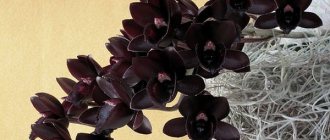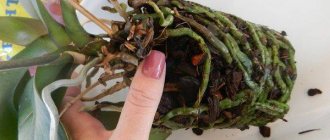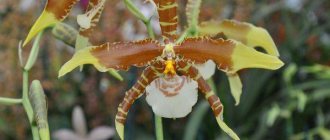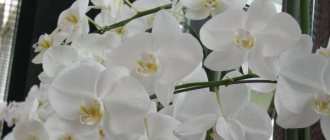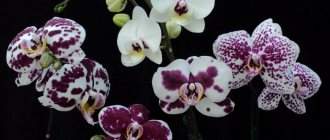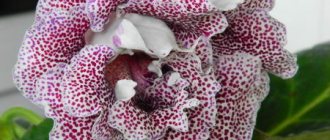Your request has been accepted!
You will receive a notification when the price of the product decreases to the contacts you specified.
Your request has been accepted!
You will receive a notification when the product goes on sale to your contacts.
Orchids are one of the oldest plants on our planet . Due to the fact that they can adapt to different natural conditions, they can be found in different parts of the world.
The most unpretentious orchid, phalaenopsis, is most often grown indoors. If you follow simple rules, it will delight you with its flowering for months.
In this article we will look at the names and photos of varieties of pink phalaenopsis.
Pink Phalaenopsis Rosea
The Phalaenopsis genus includes about 50 plant species. All of them belong to the Orchidaceae or Orchidaceae family. They are distinguished by wide leaves and butterfly-like flowers, the petals of which are complex and painted in pastel colors.
Pink phalaenopsis (Phalaenopsis rosea) is one of the smallest subspecies, an epiphyte . The plant's favorite habitat is river banks.
The rosette consists of 2-5 oblong leaves, up to 20 cm long and about 5 cm wide. On a short peduncle about 30 cm long there are about 15-20 small white-pink flowers , which bloom one after another.
The inflorescence can be simple or branched, arched. The size of the flowers in diameter is 25 mm.
Flower appearance:
- sepals are pink in color with vertical white stripes, oblong;
- the lip is small with three lobes, colored from pink to dark purple.
Phalaenopsis can delight you with its flowering at any time of the year. “Children” regularly appear on faded flower stalks, which can be used to propagate the plant.
Phalaenopsis rosea is native to the lowlands of the Philippine Islands and Taiwan.
Artificially bred
In addition to flowers growing in the wild, there are a huge variety of artificially bred phalaenopsis intended for indoor breeding. Their inflorescences can be very different, including the most original colors.
The most common type of indoor orchid is the pink phalaenopsis with buds that look like beautiful butterflies.
The diameter of the buds reaches 3 cm; up to 10-15 pieces can be located on the peduncle.
Phalaenopsis is mainly bred and grown in Holland. It takes more than one year and many transplants for a tiny seedling to grow into a flower capable of decorating our homes.
In laboratory conditions, microscopic orchid seeds are placed in glass flasks filled with a special substrate. It is from them that, after a long time, magnificent pink phalaenopsis appear.
More types and varieties of pink phalaenopsis orchids
In the collections of flower growers you can find both species phalaenopsis and hybrid varieties with pink flowers.
Schiller
Among the most common is Schiller's phalaenopsis (Phlaenopsis chilleriana). Homeland - Philippines. The peculiarity of the species is its variegated leaves with a silvery coating, with dark green spots uniting into stripes.
Phalaenopsis Schiller 'Wilson'.
Phalaenopsis schilleriana - photo from Wikipedia.
It is this type of phalaenopsis that is the “father” of most hybrids. The huge number of flowers on the peduncle is another highlight. A record case – 174 flowers on a peduncle!
Stewart
Stuart's phalaenopsis (Phlaenopsis Stuartiana) is very similar to the previous species. The difference is in the branching peduncle with medium-sized flowers with a specific pattern. Its homeland is the island of Mandanao in the Philippine archipelago.
Mini and midi
Phalaenopsis minis are distinguished by their miniature size . Midi orchids are slightly larger - 40-55 cm high, with a leaf length of up to 20 cm and a peduncle thickness of about 7 mm. Among them there are also flowers with a pink color.
Phalaenopsis mini. Please write in the comments what variety it is.
Hybrids
Hybrid varieties of phalaenopsis orchids:
- pink-cherry phalaenopsis;
- pink Dragon;
- blue pink;
- pink Panther;
- pink dreams;
- Grandiflora Chameleon pink;
- royal double pink phalaenopsis.
Phalaenopsis Pink Dragon.
Pink Phalaenopsis Singolo.
Pink Panther (Phal. Pink Panther).
Phalaenopsis Pink Dream (Pink Dreams).
Pink royal phalaenopsis.
Amazing flowers can hardly leave anyone indifferent. Despite their exotic appearance, they are the most unpretentious representatives of the Orchid family. They can be easily found on the shelves of flower shops and apartment window sills.
At home, there are about 70 different plant species , as well as artificially grown hybrids. The varieties differ from each other in the color of the inflorescences, the size of the leaves and the shape of the petals.
If you follow simple care rules, phalaenopsis can bloom for about 4 months, sometimes even 2-3 times a year. Not only experienced gardeners, but also beginners can pacify exotic flowers.
For good growth and development, the plant must create optimal conditions:
- lighting at the location;
- content temperature;
- air humidity;
- watering and fertilizing;
- substrate and transplantation;
- periods of rest and active growth.
Optimal conditions of detention
Phalaenopsis is not too picky about lighting conditions. Still, a more favorable location for it would be under diffused light from the sun , for example, on a windowsill near an eastern or western window.
Direct sunlight can burn the leaves of the plant, so a south window is not the best option for it. If you want to place the plant far from the window, it will need additional lighting with special lamps.
Daylight is desirable until 12 - 15 hours. In winter, it is also useful to use lighting.
Since the plant’s homeland is tropical rainforests, in spring and summer it is necessary to maintain the temperature 20 - 24 degrees Celsius , not allowing it to drop below 18 degrees. From the beginning of autumn until spring – preferably at least 20 degrees.
Phalaenopsis love fresh air with high humidity, but are afraid of drafts. During ventilation, do not allow cold air to enter the plant.
In winter, due to central heating, air humidity decreases, so phalaenopsis must be sprayed frequently. The procedure is carried out carefully, preventing water from entering the rosette of leaves. If an incident occurs, you can extract the moisture using a cotton swab by blotting the core.
In winter, orchids need spraying.
If the tips of the aerial roots are rich green, there are no problems with air humidity.
Watering
The frequency of watering depends on the periods of its development. During growth and flowering, the substrate should be kept moderately moist. From the beginning of the dormant period, the number of waterings decreases, but overdrying the substrate is unacceptable.
Transparent containers in which orchids usually grow will help determine when the plant has rested and entered the growth stage. To do this, you should inspect the roots:
- The green color of the root tips indicates that the plant is beginning to grow;
- During the dormant period, the tips are a uniform brown-reddish-green color.
For irrigation, it is advisable to use soft water at room temperature, which does not contain salt or impurities. Ideal option: distilled, rain or melt water.
Top dressing
Feeding is carried out infrequently, during the growth period once every 20-25 days. In this case, special complex mineral fertilizers for Orchids are used. It should be noted that the period of active growth can occur in any time period.
Transfer
The factor determining the need to transplant a plant into a new substrate is its growth. If growth has slowed down, then the orchid has “outgrown” the container and should be replanted.
The transplantation procedure requires care; it is important not to harm the roots. If possible, the old flowerpot should be cut and the root system carefully removed without destroying the substrate.
The new pot shouldn't be much larger. The choice should be made on a transparent plastic container, because it is also important for the roots to receive light.
It is better to take a soil mixture special for orchids or prepare it yourself from pieces of pine bark, sphagnum moss, charcoal and fern roots.
In general, an orchid is usually replanted once every 2 years, waiting until the end of flowering.
Bloom
The periods of rest and growth of phalaenopsis are not as noticeable as in some other varieties of orchids. Rest is determined by the general condition of the plant.
The dormant period begins after flowering. At this time, it is advisable to reduce the air temperature to 16 degrees Celsius. There is no need to replant or feed the plant.
There is no need to trim the old peduncle. If it has not dried out, you should shorten it by only 2 eyes.
Phalaenopsis blooms almost all year round. In this case, new flower stalks are formed twice a year.
To stimulate flowering, you can “organize” a difference in night and day temperatures for 2-4 weeks, as in natural conditions. This will stimulate the formation of new flower stalks. Before they appear at night it should be 16-18 degrees, after - 20-22 degrees.
But from overwatering, the roots of the plant can suffer and rot. In such a situation, transplantation into a new container and a new substrate is necessary.
After purchasing in store
When purchasing an orchid in a store, you should pay attention to its general condition, roots and peduncle. In healthy specimens, the leaves are elastic, dark green, do not wrinkle, the roots are green or grayish, the aerial roots are hard and elastic.
The peduncle should have blooming flowers and buds. There should be no rot in the socket.
Home care
For a pink orchid it is necessary to provide certain living conditions.
Temperature
The optimal temperature will be 20 °C in winter and up to 35 °C in summer. In the cold season, a drop in night temperature to 10 °C can be detrimental to the flower.
Accommodation
Windows facing east or west are suitable for orchids. On particularly hot sunny days, the orchid needs shading. Bright light gives flowers a bright color, but in large quantities causes burns.
Lighting
In winter, the flower needs additional lighting with fluorescent lamps in the evening, since it needs 12 hours of daylight to grow.
Watering
Watering for pink orchids is moderate. In summer, the soil is moistened several times a week as it dries; in cold weather, it is reduced to several times a month. The roots of the plant behave especially capriciously. Overdrying, like excess moisture, leads to their death.
Water is used at room temperature. You need to make sure that all the soil is saturated with liquid. To do this, you can lower the pot into a bucket of water and then let the excess drain off.
To increase air humidity, place a tray with pebbles filled with water near the pot.
Fertilizer
Phalaenopsis needs to be fertilized with a special complex product for orchids. It can only be added to a moistened substrate so as not to burn sensitive roots.
The procedure is carried out once every two weeks during the period of active growth. Excess fertilizer leads to cracked leaves and prolonged absence of flowering.
Classic varieties of pink orchids with photos
Today you can find a large number of varieties of pink orchids at the flower market. Almost all of them require the same care. Thus, you can choose based on your own preferences. However, you need to understand that it is better to purchase planting material in specialized stores. There he is not infected, so he can live for quite a long time. It is worth taking a closer look at the most popular varieties.
Schiller
This is the most common flower that can be found among domestic plant growers today. It also grows in the natural environment.
Here are the features of this type:
- The plant can reach 100 cm in height.
- The root system is quite developed.
- The leaves completely hide the stem. They are bright green. Wiry, the size can reach 60 cm in length and 10 cm in width.
- The flowers have a delicate pink color. They are small and there are a lot of them. The recorded record is 174 flowers on one peduncle.
Stewart
The variety is very similar to the Schiller orchid. However there are a few differences:
- The peduncle is quite branched;
- it has a specific design;
- The flowers themselves are lighter, there is also a white tint.
Caring for this plant is standard, so it should not cause any difficulties. When creating optimal conditions, flowering can be achieved within five months.
Rosea
This is one of the most popular varieties; its small seedlings resemble butterflies in appearance.
Here are the characteristic features of this plant:
- The peduncle can reach 50 cm.
- The leaves are medium in size, rarely exceeding 30 cm in length. They completely cover the stem.
- The flowers are pale pink. Their diameter is no more than 3.5 cm.
- The buds open gradually, allowing you to enjoy long-lasting flowering.
Mini phalaenopsis
This is a unique orchid that has the following characteristics:
- The size of the peduncle does not exceed 20 cm.
- The buds are pink and may have different patterns on the petals.
- The lip is standard, like the Schiller and Stewart varieties, but smaller.
Varieties of salmon-colored plants and photos
At home, you can grow different varieties of pink phalaenopsis. The most common types of orchids are:
Liodoro
In the early 80s of the last century, the Liodoro variety was developed, which after a short time won numerous awards at exhibitions and began to be loved by Europeans.
The length of its peduncle is about 50 cm; medium-sized flowers bloom on it alternately.
Liodoro buds are distinguished from other varieties of orchids by their unusual coloring. The edges of the petals are yellowish-cream in color, gradually giving way to pink, and then turning into a purple core.
Schiller
Schiller's phalaenopsis (Phlaenopsis chilleriana) is native to the Philippines. Flowers can reach 7 cm in diameter. But the distinctive feature of this variety is its variegated leaves with dark green and silver-gray spots, which can be combined into stripes.
Stewart
Stuart's phalaenopsis (Phlaenopsis Stuartiana) came to us from the island of Manandao in the Philippine archipelago. Unlike the previous variety, it has small-sized flowers with a specific pattern of yellow and pink dots.
Philadelphia
A descendant of Stewart and Schiller orchids, Phalaenopsis Philadelphia is distinguished by marbled leaves, silver-green in color and pink-violet buds.
Mini and midi
The flowers of miniature phalaenopsis mini and midi, whose height reaches 40-55 cm, have a pink color.
On our website you can learn about the variety of colors of orchids and read about white, blue and yellow types.
Popular hybrids
In addition to those listed, there are also hybrid varieties of phalaenopsis. The most common among them are:
- pink cherry orchid;
- pink Dragon;
- blue pink orchid;
- pink Panther;
- pink dreams;
- Grandiflora Chameleon pink;
- royal double pink phalaenopsis.
Check out the photos of flower varieties and hybrids.
Phalaenopsis Pink Dragon:
Pink Panther:
Grandiflora Chameleon pink:
Hybrids
There are many hybrids among orchids. These are varieties that were bred through selective breeding. They do not grow in the natural environment, but they are better adapted to life in indoor conditions than others. That is, this culture does not react so quickly to changes in external factors, making it more suitable for novice gardeners.
The Dragon
This is one of the most popular hybrids today. Here is a brief description of it:
- The height of the peduncle can reach 60 cm.
- The stem is thin, dark in color, completely hidden by leaves.
- The leaves are hard and bright green. There can be up to six of them.
- The flowers have a typical orchid shape. Delicate, pink. There are a large number of dark dots on the petals.
- The lip is yellow-white. There are also dark spots on it.
This plant has extraordinary beauty and is also very easy to care for. That is why many gardeners today prefer to grow this particular variety of orchids at home.
With white spots (Panther)
This is another classic orchid hybrid that was obtained through selection. It is not found in the natural environment.
Externally, the flower is similar to the Dragon orchid, but there are differences:
- five petals white;
- there are a large number of pink spots of different shapes and sizes on the petals;
- the lip is completely pink, separated from the main flower by about two centimeters.
The panther is an incredibly beautiful flower, which at the same time requires standard care. The height of the peduncle can reach 60 cm.
Royal terry
This orchid is a little different from all the others. Here are its features:
- The size of the plant reaches one meter.
- The flower is regular in shape, completely pink. There are no inclusions on it. The buds are large and emit a pleasant aroma.
- The flowers are light and beautiful, pink in color.
Rules for planting and propagation
Experienced plant growers know that the growth rate of an orchid and its condition depend on proper planting. It is impossible to achieve flowering if the crop does not receive everything it needs.
The landing process itself is standard, but there are some nuances:
- Only a transparent pot is used. This can be an ordinary plastic container or container.
- A special soil is poured into it, which you can buy or make yourself. If you want to perform all the operations yourself, you will need to mix tree bark with moss, add lowland peat and charcoal. It is imperative to provide a good drainage layer, because stagnation of moisture is detrimental to the orchid.
- The orchid is removed from the old pot and placed in a new one.
- Sprinkle a little soil on top without completely covering the aerial roots.
A domesticated orchid can be propagated in the following ways:
- dividing the bush;
- basal children;
- cuttings;
- children on a peduncle;
- seeds.
The flower does not tolerate external influences well, so you can divide the bush only not during flowering. Otherwise, it will take a long time for the culture to fully recover. Moreover, the plant will not produce flower stalks for the next year or even two.
Transfer
For pink orchids, a soil consisting of chopped pine bark, moss and charcoal is suitable. For planting, it is better to use transparent plastic pots. In this case, you can monitor the condition of the root system in order to prevent the death of the plant in time, and monitor the need for moisture.
A flower is replanted only in conditions of extreme necessity, not more than once every few years. If the roots occupy most of the pot and the plant’s growth has slowed down, it is worth replacing it with a larger one. The orchid is replanted only after flowering.
A layer of drainage is placed at the bottom of the pot, dried roots are cut off and cleaned of old soil. The plant is placed in a new pot and carefully covered with substrate, without pressing down, so as not to damage the fragile rhizome.
The peduncle that points upward looks beautiful. To do this, you need to tie it to a discreet support, which is carefully inserted into the ground, trying not to damage the roots.
Features of care
It is necessary to properly care for the orchid so that it blooms profusely and delights with its rapid growth. To do this, you need to pay close attention to some factors:
- illumination;
- air temperature;
- watering;
- feeding
It is worth considering all this in more detail.
Temperature and lighting
Orchids are very sensitive to light. They need a lot of light, so it is recommended to place them on the south side. At the same time, plants are afraid of direct sunlight, so the light should be diffused. If the orchid has just been purchased, it must be placed in a dark room for a couple of days so that it can acclimatize faster. Only then is the plant provided with sufficient light.
As for temperature conditions, here are the basic rules to remember:
- during the day the temperature is up to +27 degrees;
- at night about +18 degrees;
- Changes of more than five degrees are prohibited, after which the orchid will get sick and drop its leaves.
Thus, being in an apartment allows the culture to feel comfortable at any time of the year.
Watering and fertilizing
Orchids need a lot of moisture in the air, but there is no need to flood them. Otherwise, there is a high risk of rotting roots or leaves.
Here are the basic rules for watering:
- It needs to be watered once every 7-10 days.
- During the flowering period - less often, every 10–12 days.
- If it's hot outside, watering is done every 2-4 days.
- You can determine whether it is necessary to water by looking at the top layer of soil: if it is dry, it should be moistened.
- Spraying is required periodically. However, water should not get into the rosettes of the leaves, as this can cause rotting.
The plant definitely needs feeding. You can find fertilizers for orchids in specialized stores. It is required that they have enough potassium, phosphorus and superphosphate. Fertilizers are applied exclusively in liquid form every 20 days. The first time you need to dilute less substance than indicated in the instructions. This is necessary to check how the orchid will react to feeding. If no side effects are detected, you can fertilize according to the instructions.
During the flowering period
During flowering, the crop consumes a large amount of minerals. Also, the flower is highly susceptible to external factors.
Therefore, a blooming orchid must provide the following conditions:
- optimal temperature conditions;
- proper watering;
- more abundant feeding.
It is forbidden to move the plant during the flowering period or carry out any manipulations on it: replanting, cuttings, etc. It can quickly shed all its buds and begin to fade. Therefore, you first need to wait for the end of flowering, and only then carry out the planned actions.
Does a flower of this color exist in nature?
Pink phalaenopsis grow in the humid tropical climates of Southeast Asia and Australia. In the wild, they grow in moist, shaded areas above streams and swamps. The ambient temperature in the tropics ranges from 19 to 27 degrees throughout the year, and the difference between winter and summer temperatures is not too great.
Orchids grow on trees, entwining them with their roots. However, flowers are not parasites. Nutrients - plant residues preserved in the rotted bark of trees - are obtained by phalaenopsis from their aerial roots. They also absorb water - rain or from fog drops - with their roots. Orchid trees are used to rise higher towards the light in dense jungle vegetation.
Diseases and pests
Periodically, the orchid is attacked by various pests:
It's quite difficult to fight them. If a thin mite leaves the plant when air humidity rises, then other pests need to be fought by destroying their eggs. For this, special poisons are used . However, they must be used in small quantities so as not to harm the culture itself.
As a result, the effectiveness of control is reduced, but the flower is preserved. To get the desired result, it is necessary to carry out not 2-4 sprayings, but about eight due to the reduced dosage of the chemical.
Thus, pink orchid varieties require standard care. It is recommended to buy soil in special stores to avoid problems with pests. With proper care, they will not appear, and the flower itself will feel great.
If the leaves begin to turn yellow, it is necessary to adjust the intensity of watering. If there is root rot, it is necessary to dry them and replant the plant. The flower will thank you for your care with long and intense flowering, which can last for several months.
Home care
For a pink orchid it is necessary to provide certain living conditions.
Temperature
The optimal temperature will be 20 °C in winter and up to 35 °C in summer. In the cold season, a drop in night temperature to 10 °C can be detrimental to the flower.
Accommodation
Windows facing east or west are suitable for orchids. On particularly hot sunny days, the orchid needs shading. Bright light gives flowers a bright color, but in large quantities causes burns.
Lighting
In winter, the flower needs additional lighting with fluorescent lamps in the evening, since it needs 12 hours of daylight to grow.
Watering
Watering for pink orchids is moderate. In summer, the soil is moistened several times a week as it dries; in cold weather, it is reduced to several times a month. The roots of the plant behave especially capriciously. Overdrying, like excess moisture, leads to their death.
Water is used at room temperature. You need to make sure that all the soil is saturated with liquid. To do this, you can lower the pot into a bucket of water and then let the excess drain off.
To increase air humidity, place a tray with pebbles filled with water near the pot.
Fertilizer
Phalaenopsis needs to be fertilized with a special complex product for orchids. It can only be added to a moistened substrate so as not to burn sensitive roots.
The procedure is carried out once every two weeks during the period of active growth. Excess fertilizer leads to cracked leaves and prolonged absence of flowering.
When choosing fertilizers, you need to pay attention to those that contain a minimum amount of nitrogen.
